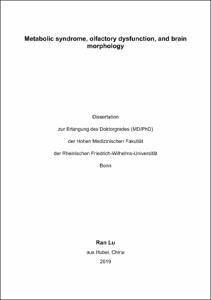Metabolic syndrome, olfactory dysfunction, and brain morphology

Metabolic syndrome, olfactory dysfunction, and brain morphology

| dc.contributor.advisor | Breteler, Monique | |
| dc.contributor.author | Lu, Ran | |
| dc.date.accessioned | 2020-04-25T18:02:03Z | |
| dc.date.available | 2021-09-01T22:00:23Z | |
| dc.date.issued | 03.09.2019 | |
| dc.identifier.uri | https://hdl.handle.net/20.500.11811/7726 | |
| dc.description.abstract | Both metabolic syndrome (MetS) and olfactory dysfunction are highly prevalent disorders, and closely related to brain function. Although several studies implied a link between several components of MetS and olfactory dysfunction, it remains unclear how MetS influences olfactory function. Furthermore, the neuroanatomical basis of neither MetS nor olfactory dysfunction is well understood in the general population. Therefore, based on the first 2000 participants from the Rhineland Study, a population-based cohort, we aimed to elucidate the relations between metabolic syndrome, brain structure, and olfactory function. MetS was defined in accordance with revised criteria of National Cholesterol Education Program Adult Treatment Panel III. Brain structures were assessed on high-resolution T1- and T2-weighted brain images at 3 Tesla. Performance on the 12-item "Sniffin' Sticks" odor identification test was used as a proxy of olfactory function. For this thesis, I first systematically examined the relation of MetS and insulin resistance with both olfactory brain structures and function. I found that MetS and insulin were associated with several olfactory brain structures, i.e. entorhinal cortex, insula, and lateral and medial orbitofrontal cortex, but not with objectively quantified olfactory function. Subsequently, I further investigated the association between olfactory brain structures and olfactory function. I found that olfactory bulb volume (OBV) was not only consistently associated with olfactory function, but also with several central odor-related structures across all age groups. Moreover, OBV played a mediatory role in the association between volumes of central olfactory structures and olfactory function. Finally, I examined the relation between MetS and insulin resistance and brain morphology using vertex-based analyses. I observed that MetS and insulin resistance are related with a very similar spatial pattern of brain cortical thinning. Additionally, insulin resistance accounted for most of the MetS-related brain alterations. In conclusion, the work described in this thesis provides new evidence for the association of MetS and insulin resistance with olfaction, and sheds light upon the neuroanatomical correlates of both olfactory function and MetS. | en |
| dc.language.iso | eng | |
| dc.rights | In Copyright | |
| dc.rights.uri | http://rightsstatements.org/vocab/InC/1.0/ | |
| dc.subject.ddc | 610 Medizin, Gesundheit | |
| dc.title | Metabolic syndrome, olfactory dysfunction, and brain morphology | |
| dc.type | Dissertation oder Habilitation | |
| dc.publisher.name | Universitäts- und Landesbibliothek Bonn | |
| dc.publisher.location | Bonn | |
| dc.rights.accessRights | openAccess | |
| dc.identifier.urn | https://nbn-resolving.org/urn:nbn:de:hbz:5-55615 | |
| ulbbn.pubtype | Erstveröffentlichung | |
| ulbbnediss.affiliation.name | Rheinische Friedrich-Wilhelms-Universität Bonn | |
| ulbbnediss.affiliation.location | Bonn | |
| ulbbnediss.thesis.level | Dissertation | |
| ulbbnediss.dissID | 5561 | |
| ulbbnediss.date.accepted | 28.08.2019 | |
| ulbbnediss.institute | Angegliederte Institute, verbundene wissenschaftliche Einrichtungen : Deutsches Zentrum für Neurodegenerative Erkrankungen (DZNE) | |
| ulbbnediss.fakultaet | Medizinische Fakultät | |
| dc.contributor.coReferee | van der Lugt, Aad | |
| ulbbnediss.date.embargoEndDate | 01.09.2021 | |
| ulbbnediss.contributor.gnd | 1240441231 |
Files in this item
This item appears in the following Collection(s)
-
E-Dissertationen (1588)




